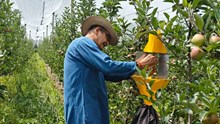
Bush Plum is scientifically referred to as Carissa spinarum. It is an evergreen shrub with thorns that grows to a height of 3 meters. It occurs in wild patches, farm boundaries, forest margins, and dry pasturelands. Its glossy green, thick leaves, white star-shaped flowers, and robust spiny shoots make it possible to identify easily. The green, small fruits that turn black or dark purple are common to many children in rural areas, who pick and consume them while tending cattle or returning from school.
It is known as Vakkay in Andhra Pradesh and Telangana. In Rajasthan and Madhya Pradesh, it goes by the name Jungle Karonda or Kair. In north India, it is locally known as Jamrasi or Kalakate. These names show local connections and the fact that the plant is widely distributed throughout the drylands of India.
Folk Wisdom and Medicinal Uses
One of the primary benefits of this plant is its fruit. The mature berries, although tiny and sour-tasting, are full of Vitamin C and antioxidants. They are usually consumed fresh or converted into chutneys and pickles by local communities. Some communities even dry the fruit and utilize the powder as a traditional remedy.
In traditional medicine, roots, leaves, and fruits of Vakkay or Jamrasi are employed to alleviate stomach ailments, fever, skin diseases, and cuts. The root paste is applied to boils and swelling conditions. The juice of the fruit is said to provide relief from gastrointestinal conditions and strengthen immunity. Such traditional uses reflect how deeply this plant is embedded in the day-to-day lives and health traditions of rural households.
Natural Live Fencing
For Farmers, Conkerberry is a natural blessing for fencing. Its dense, thorny nature makes it a wonderful live fence against stray goats, cattle, and even wild animals. In contrast to barbed wire or concrete walls that cost money and need periodic maintenance, a Jungle Karonda hedge once established will be maintained for decades with minimal attention.
In most villages, the shrub is still cultivated around fields by farmers to guard crops. As the plant develops, it creates a dense green barrier that serves not only to repel animals but also to give shelter to birds and beneficial insects. It strengthens the local ecosystem and aids in the pollination of surrounding crops such as vegetables, fruits, and pulses.
Restoring Wastelands and Dry Soils
Most farmers in India have land that has been degraded by erosion, dry, or rocky. It is hard to cultivate such land, but indigenous shrubs such as Kair or Kalakate can restore such zones to life. Conkerberry thrives in poor soils, is drought-resistant, and even allows some salinity. With establishment, its roots stabilize the ground, mitigate erosion, and enhance water holding capacity.
In pasture land use and agroforestry, the plant may be employed to cover abandoned land, suppress dust storms, and form shelterbelts. In the long term, this results in enhanced soil fertility as well as enhanced water availability for neighboring crops.
Emergency Fodder and Firewood Support
Although it is not a normal fodder crop, under conditions of shortage, goats and sheep tend to graze on the soft leaves and young shoots of Vakkay. This comes particularly handy during drought seasons or summer months. The hard branches, when dried, also find use as firewood in traditional villages, lessening the necessity to fell trees from forests.
Thus, whether it is a few leaves for a hungry goat or a few dried branches for preparing evening dinner. This humble shrub silently sustains rural existence in numerous ways.
How to Grow and Use It on Farms
Farmers willing to make use of Conkerberry in fencing or to enhance the soil can cultivate it with seeds or root suckers. Seeds are to be obtained from mature fruits and planted in sandy or loamy soils. Sunny places are most preferred and do not need frequent watering after the initial months.
To create a live fence, Farmers should grow juvenile saplings on an approximately 1-meter spacing at the field boundary. Pruning in the early years will cause the plants to become bushy and thick. It needs minimal maintenance and no chemical inputs once matured.
In the fast-paced world of agriculture today, native and traditional plants like conkerberry are frequently overlooked. However, this humble shrub gives farmers optimism in the face of deteriorated soils, unpredictable rains, and growing expenses. Its value is the same whether it is referred to as Vakkay, Kalakate, Jungle Karonda, or Kair: a reliable, multipurpose plant that yields more than it consumes. We can transition to more resilient, affordable, and sustainable farming by returning such natural species into farms and landscapes. It's time to incorporate conkerberry and other natural guardians into our farming future and rediscover their silent power.
















